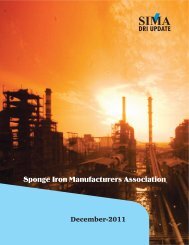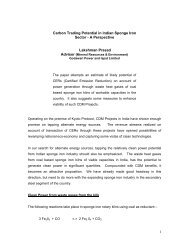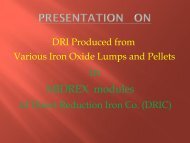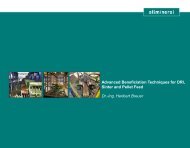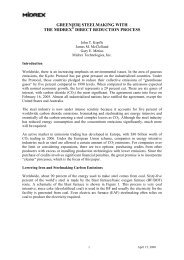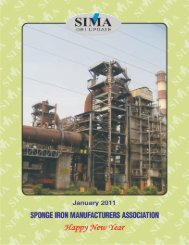You also want an ePaper? Increase the reach of your titles
YUMPU automatically turns print PDFs into web optimized ePapers that Google loves.
The global steel industry is inching forward. An<br />
industry, which was characterized as Sunset industry<br />
two decades ago, is experiencing a vast change in<br />
scenario. World Crude steel production achieving a<br />
growth of 8.85% in 2006 over 2005. Major share<br />
coming from Asian continent, China and India being<br />
the major contributor achieved a substantial growth<br />
of 17.7% and 15.5% respectively.<br />
CRUDE STEEL PRODUCTION (million tones) &<br />
GROWTH RATE – (WORLD vis-à-vis INDIA)<br />
GAS BASED SPONGE IRON<br />
Can India expect any growth in the future in this Sector?<br />
PRAKASH TATIA-Vice President (Marketing) VIKRAM ISPAT, Bombay<br />
Average Per capita consumption of steel in world<br />
was around 189 Kgs in year 2005. However in India<br />
it was still 37.6 Kgs during the same year.<br />
PER CAPITA CONSUMPTION (IN KGS)<br />
From the above, It is noted that there is a huge<br />
untapped potential present in Indian market. Now<br />
the trend is changing from past couple of years, with<br />
consistent growth in Economy, huge investments<br />
coming from Domestic and International players in<br />
Infrastructure & development, Automobile sector,<br />
Industrial engineering, Oil & Gas sector thereby<br />
increasing the demand of steel in India. Hence, Steel<br />
Industry in India is entering a rapid growth phase.<br />
With such huge demand it is also expected<br />
production of steel would be triple by 2020 around<br />
110 MMT.Infact, now analysts are talking about more<br />
than 200MMT production by 2020. Growth in various<br />
sectors like Construction, Automobile & Engg is the<br />
main driving force behind such growth and with<br />
number of players increasing in each sector, Every<br />
player is looking to differentiate its product yet being<br />
cost competitive which is ultimately driving the<br />
demand for quality steel in the market. This demand<br />
for quality and various grades of steel by end users<br />
segments is forcing Steel manufacturers to opt for<br />
the best possible route for steel making.<br />
CRUDE STEEL IS PRODUCED IN INDIA BY TWO<br />
ROUTES<br />
Primary Route (CAGR of 3.9% (FY 94-06)<br />
Secondary Route (CAGR of 11.10% (FY 94-06)<br />
As per MIDREX Secondary Steel making process<br />
continues to grow because of its capital and<br />
operating cost advantage, flexibility for<br />
manufacturing various grades of steel, Relatively<br />
Environment friendly and Economies of scale. A large<br />
growth in world steel industry will be via Secondary<br />
route. This growth results in increased demand for<br />
metallic required for Secondary steel making route<br />
i.e. Scrap, DRI, HBI, and Pig Iron. However Since<br />
Scrap is not a manufactured commodity, there are<br />
limitations on growth in supply (especially Quality<br />
Scrap) and Pig iron having its limitation of usage in<br />
secondary route. Given these limitations, Sponge<br />
Iron (DRI/HBI) becomes the most preferred metallic<br />
MAY-<strong>2007</strong>/11



